SEARCH SITE
Autoclave Types
ASC Process Systems manufactures many types of autoclaves systems for the thermal processing and bonding industries world wide.
Field-built Autoclaves
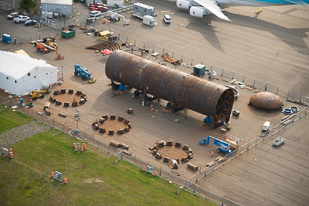
Field fabrication of an ASC 28 ft. x 120 ft. autoclave
When autoclaves become too large to transport by truck, the autoclave must be built entirely in the field. ASC is one of the most experienced autoclave field-fabricators in the world, with multiple and concurrent field projects every year.
When does field fabrication make sense?
When an autoclave internal diameter exceeds 12 ft. (3.6 m), the cost of transporting the autoclave across the country can become very expensive. ASC will typically perform a cost-benefit analysis to determine what fabrication method will provide the best value to the customer. Due to weather and other factors, field fabrication is inherently less efficient than shop fabrication, so all of the factors must be weighed together.
How long does field-fabrication take?
Field fabrication time can be as low as 50 weeks to turnover and as high as 90 weeks. Time depends on the size and complexity of the autoclave, and also the current lead-time for steel, heads, and forgings.
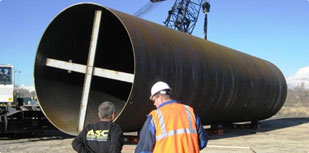
Multiple sections welded together into a cylindrical vessel
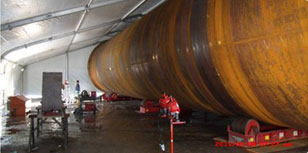
Field fabrication with tent erected over vessel
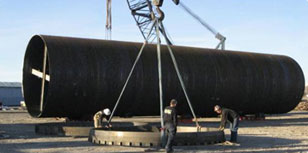
Locking ring forgings being positioned for assembly.
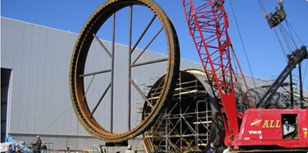
Shell flange and locking ring being positioned on vessel.
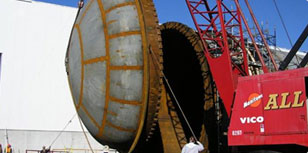
Head and head flange being positioned on vessel.
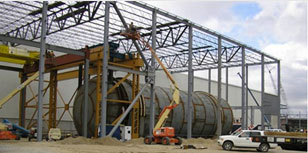
Fabrication area being prepared for turning rolls
The process of field fabrication
For field-fabrication projects, ASC will work with the customer closely to determine where the vessel and autoclave will be built. If the customer can have the autoclave pit foundation ready in time, ASC prefers to build the autoclave in the pit. This however is not always possible, either due to building and foundation not being ready, or restrictions and complications due to concurrent customer production requirements. In this case, ASC will ask the customer to provide a nearby concrete pad that can be used for the build effort.
Once the project commences, ASC will immediately purchase vessel heads, steel plate, and door forgings to be used for the pressure vessel. The plate steel will come directly from a mill and lead-times can be expected to be 10-14 weeks. Once the steel is ready for delivery, it will be shipped to a nearby vendor for rolling services. After rolling, which might take 2-3 weeks, the rolled shell sections will be delivered to the field fabrication site. The heads will come from a specific head vendor, and will require anywhere from 14-20 weeks depending on size. The forged locking ring parts (shell flange, locking ring, and head flange) will require 10-12 weeks for forging and then another 8-12 weeks for machining. Once the rolled steel sections arrive at the site, ASC field personnel will crane each individual section from the truck and position them on pre-placed turning rolls. Turning rolls are heavy-duty machines that are used to rotate the vessel sections so that automated sub-arc welding machines can be used to weld the girth seams of the vessel.
At this point, the field staff might number 3-4 workers, and their task will be limited to welding the sections together using stick-welding (root pass) and sub-arc (cover passes). Unfortunately, only one girth or long-seam weld can occur at the same time, so the work effort is somewhat limited. This process of welding girth-seams and long-seams can take a number of months depending on the size of the pressure vessel.
Unlike shop-fabrication, working in the field brings additional costs, including required coverage for bad weather and cold conditions. In certain cases ASC will tent the autoclave during critical fabrication processes.
At some point during the seam-welding process, the front and rear heads should arrive at the site. Large heads might come in one section or might be split to allow for transportation. When the rear head arrives at the site, it will be offloaded and immediately placed on the end of the shell section assembly. When the machined locking-ring parts arrive at the site, the field personnel will begin the fit-up and welding of the door assembly. This involves positioning and welding of angled wedges on the lugs, attachment of hydraulic cylinders, and welding the front head to the forged head flange.
Once the assembly has been wedged, the shell flange and locking ring forgings will be removed from the assembly and placed onto the pressure vessel. The shell flange forging will be welded to the main cylinder.
When the main "straight-shell" cylinder is fully welded, the field supervisor will begin to layout and drill vessel penetrations. This process will require 2-3 days. Once the layout is complete, the field team will begin the process of placing and welding nozzles, flanges, and other penetrations into the vessel. This process can be 2-4 weeks depending on the complexity and quantity of penetrations. Once all penetrations are fully welded, the autoclave can be removed from the turning rolls and placed on the steel saddles. The saddles designed to cradle the pressure vessel and spread it's load to a large footprint. The saddles are either pre-fabricated and shipped from ASC's shop or are built in the field. A large crane is used to lift the pressure vessel off of the turning rolls and onto pre-placed saddles. Also at this time the front head and head flange will be craned into place at the front of the autoclave and temporarily locked into place. At this time, the field personnel will begin the attachment of the hinge and/or door movement assembly. This assembly will typically be pre-built in ASC's shop or in some cases in the field.
Finally, when the vessel is completed and all vessel pre-inspections, x-ray inspection, and heat-treating is complete, the pressure vessel is filled with water and a hydrotest is performed. The hydrotest is used to safely pressurize the autoclave to 130% of maximum design pressure to test and validate the autoclave design. The hydrotest is witnessed by an authorized pressure vessel inspector and if all goes well, the inspector will sign-off the ASME U1A data report, indicating completion of the pressure vessel build.
Once the vessel fabrication is complete, ASC will increase manpower to the site and begin the work necessary to make the pressure vessel into an autoclave. This will include 15-25 field personnel who will fabricate and install insulation, liner, floor, fan assembly, and all other elements of the autoclave. For very large vessels, the door gantry assembly will also be fabricated during this time. Once the autoclave-build activities are underway, ASC will discuss with the customer the rigging and movement of the pressure vessel from the fabrication location to it's final location in the pit. The total time to build the autoclave after the pressure vessel hydrotest is usually 4-6 months.







 AUSTRIA
AUSTRIA BRAZIL
BRAZIL CHINA
CHINA FRANCE
FRANCE GERMANY
GERMANY ITALY
ITALY JAPAN
JAPAN LATIN AMERICA
LATIN AMERICA RUSSIA
RUSSIA SOUTH KOREA
SOUTH KOREA SPAIN
SPAIN UK
UK USA
USA